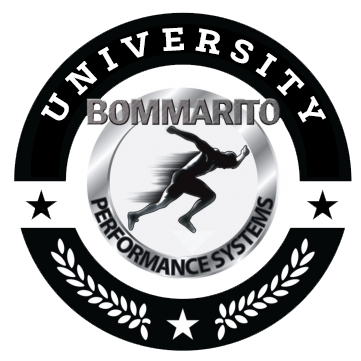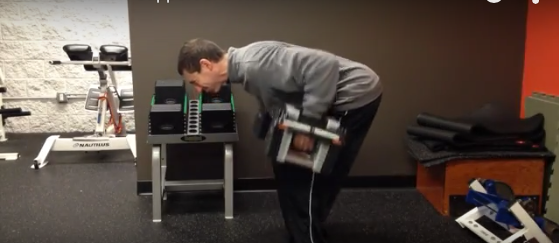Keith Shimon MATcs
Row Dissection: Progressions and Tools
Part 1: Restraint and Effects On Force Output
“What is the best way to row?” “What is the best row machine?” “Are machines evil
or bad, and should I only use barbells, dumbbells, bands, or body weight?”
As professionals you hear a gamut of questions and exercise mythology. Is there
really a “best row?” Maybe a “best row” exercise for a specific individual. It all
comes back to the question of “who is it for,” and “what is the goal of this exercise”
(Purvis, 2013, Exercise mechanics lecture). Through the years we have all been introduced
to the standard ideology of what a rowing motion looks like. I imagine that we also
have a framework in our head of the basic rules we were told in order to get the
most out of any rowing motion, and the specific muscles that the exercise may
challenge. In addition, we have favored machines, dumbbells, kettle bells, cables,
bands, or body weight because we were told that it was the best way to row.
This article is the first of a series. We cover the use of restraint, and the
manipulation of restraint to vary the custom training response in the context of
two row examples.
In later articles, we will examine the various tools, implements, and machines that
we use, how we use them, and why we pick them. Lastly we will discuss variations
of exercises and the ideas behind the variation in order to create even better, highly
customized exercise regardless of past exercise rules we were all taught.
In writing this series I hope to evoke ideas on how to tailor the rowing exercise to
meet the needs of the individual, and to fill in the intentional or unintentional gaps
of their training process. We will not be covering bioenergetics, energy system
development, or programing. Our primary focus is understanding the wide variety
of exercises known as “rows,” and other progressions that you can create on
demand. When a high level of structure, force, and client understanding is reached,
your exercise options are only limited by your imagination.
WHAT DO WE WANT TO TRANSFER?
Most training ideologies refer to the performance of specific exercises because they
believe that the exercise transfers to the skill an athlete is perfecting to refine their
sport. We are turning that idea on its side today and not thinking about exercise
transfer, but the transfer of effects from the exercise that is of primary importance.
When I say “row”, what pops into your head? What type of machine or implement
do you think of, or are you in crew and think of an erg? How do you perform that
row, and why do you call it what you named it? I imagine that it is much easier to
call the exercise a type of row than name all of its parts as they occur in a specific
order, that would be a nightmare. It would go something like, “Go ahead and do
one of those standing, spinal muscles stable with the hip flexed at 90 degrees,
scapular retraction, glenohumeral extension, concomitantly with elbow flexion,
followed by concomitant elbow extension with glenohumeral flexion, and scapular
protraction.” What a mess. With that description of shoulder, elbow, scapular,
hip, and spinal positions I am sure that you all have an idea in your head of what
your “row” would look like. Unfortunately without being more specific, we are not
holding into account key variables. Why aren’t we more specific with the paths of
motion, and the specific angles that we choose? Why aren’t we taking into account
at what level we are supported and at what segments we are restrained? More
importantly, why are we not listing the stuff that is not supposed to move during the
chosen movement? In some cases, this can be even more important to the stuff that
is moving.
Newton’s third law of reaction is commonly stated, “For every action there is
an equal and opposite reaction”(Norkin & Levangie, 1992, pg 15-16).
“You can only shove on something as hard as it shoves on you”(Purvis, 2013, Exercise
mechanics lecture).
Restraint (Purvis, 2013, p 8:3)
1. Support (Purvis, 2013, p 8:3)
• Types/surfaces- The higher the degree of freedom reduces output capacity
• Levels – the number of joints involved
2. Guidance (Purvis, 2013, p 8:3)
• Any passively restraining influence to the path of motion and is in addition to
the moveable resistance.
Think of support as a wide variety of options that you can choose for your client/
athlete to completely change the challenge of the exercise, without changing the
direction of the resistance or body position. It can be thought of as using a stable
surface to shove off of, whether it is standing, sitting or lying on the ground. Don’t
forget an important factor in Newtonian Physics, the lighter object moves and the
heavier object does not. You need to be able to shove in order to come up with
enough force to overcome the force of the implement.
1. Support (Types/Surfaces)- If there is a high degree of freedom, there is
a limited capacity to produce force. If there is a low degree of freedom,
the environment for output expression can increase dramatically.
If the goal is not to generate the highest force possible, but instead to challenge
maintaining an alternative position or changing positions during a row, then
understand that the maximal output to perform that lift will not be as great. That is
not a bad thing, just a different exercise with a different challenge.
2. Support (Levels)- The more body segments/joints that need to be
controlled/stabilized, the less overall output can be expressed.
Again, this is neither all good nor all bad. Progressing from supporting body just
distal to joints targeted to specifically generate output, to gradually working on
stabilizing or controlling multiple body segments in multiple directions and reducing
output to focus on body orchestrated control may be a goal. Both approaches have
their place in the grand scheme of athlete/client development.
3. Guidance – In the use of a machine, the path of motion may be defined
but you are not limited to shoving/pulling through it.(Purvis, 2013, p 12:4-5)
Machine based rowing exercise gives you a variety of experiences that you will not
get with the use of free weights, cables, or elastomers(bands). If the machine path
of motion is restrained, you get the choice of either directly opposing that path of
motion, or choosing an alternate path slightly off of that path in order to change the
challenge of exercise entirely (example: attempting to “pull apart” the handles of a
fixed row machine that has handles traveling sagittally). If you are using dumbbells,
bands, or cables you are subjected to the path of acceleration of the implement
depending on its magnitude.
TWO EXAMPLES:
1. THE DUMBBELL STANDING ROW AT 90 DEG. OF HIP FLEXION VS.
DUMBBELL CHEST SUPPORTED ROW:
See below (first video)
In this scenario we did not discuss the ideas of strength profiles and matching
magnitude profiles to create optimal resistance profiles. This will be touched
upon in a later article.
2. The XPLOAD LOW ROW UNSUPPORTED VS. SUPPORTED
See below (second video)
Remember, we are only attempting to show the difference in supporting body
segments and the ability to generate greater output. This does not mean that this is
the “best exercise,” only a way to increase the output if your goal is to generate more
force.
The possibilities of expansion of your exercise options are truly limitless. How many
ways can you choose to experiment with supporting or not supporting the body as
the force applied to the body runs with some of its direction anterior to posterior with
the point of contact being distal to the glenohumeral joint? You now have some
ideas to experiment with to fill training gaps. Then, if you choose to experiment with
exercises through the force/velocity continuum, and the endurance capacities of
each of those specific biomotor abilities, you can add valuable tools to your tool belt.
1. Norkin, C. C., & Levangie, P. K., (1992). Joint structure and function: A comprehensive analysis
2nd edition, pg 15-16. Salem, MA.
2. Purvis, T., (2013). RTS manual for the sciences of resistance exercise: Resistance mechanics, pg
12:3-6, 8:3-5. Oklahoma City, OK.
T. Purvis (2013). RTS resistance mechanics, Retrieved from Body Activation course audio
database.


